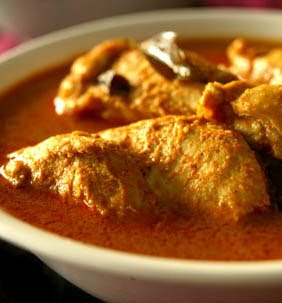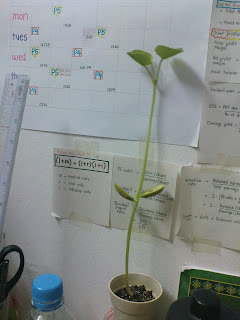June 15
This dish might not look particularly appetizing, but blame that on my photography, not on the food.
It’s ayam percik (pronounced perchik), one of the specialties of the Malaysian state of Kelantan, in the country’s northeast. It’s charcoal-grilled chicken topped with a coconut milk sauce.
Sounds good, right?
It is typically served with nasi kerabu, which is rice topped with herbs and other nutritious green things, plus bean sprouts. And two nights ago, when I took this picture, it also was served with shrimp crackers.
You can see a picture of it on the right.
Ayam percik and nasi kerabu are delicious together, they really are, and I think they’d translate well to a western state of mind.
We also had them with clams cooked in sambal (what’s not to like about that?) and peppers stuffed with fish paste and served with salted, hard-boiled eggs that were sliced in half and served still in their shells.
I suspect going to Kelantan was my doing: As this trip was being planned I mentioned to one of the organizers that I’d had the best mangoes in my life in this state’s capital, Kota Bahru.
Next thing I knew it was on our agenda.
Apparently I had given entrée to Wan Norma Wan Daud, director of the Product Section of the Product & Services Development Division of the Malaysia External Trade Development Corporation, or Matrade.
Matrade sponsored this trip, and Norma is a native of Kelantan.
We had a good time there. Kelantan, I’m told, is quite distinct from other parts of Malaysia. It’s the most Muslim of the 13 states, but also displays strong influence from its neighbor to the north, mostly Buddhist Thailand, a country of which it was once a part.
The part of Thailand that shares a border with Kelantan is actually mostly Muslim, but the Malaysian state still has a number of Buddhist temples and monasteries, and it shares some words and eating habits with Thailand, too.
The Kelantanese expressed pride in their elaborate
wau (pronounced “wow,” which, in a perfect world, is also how it would be spelled). It’s a word for kite they share with the Thais.
They also share a love for funky, fishy flavors, such as budu, made from fermented and, to my taste, slightly rotten, anchovies.
That was served to us during lunch yesterday, they day after our dinner of ayam percik and its traditional accompaniments.
Kelantan was unseasonably, unreasonably, inhumanely hot yesterday and, cognizant of the fact that I was in a serious Muslim state, I chose to forego shorts and wear long pants instead. Thus did I swelter with my fellow westerners as we were led through the market, breakfasting on a hot soup of laksam — sort of like boiled rice gnocchi — and looking at the region’s signature blue rice, dyed from a flower we haven’t yet identified, and at silks [June 16 update: the flower, according to my new friend
Krista, is bunga telang; she hasn’t lied to me yet].
I had Paco buy some mangosteens — a fruit I’ll discuss later, along with the salak that we’d found the night before — before we went off to look at how serunding and dodol were made.
Remember, it’s easily 90 degrees out. And humid. Feel your scalp as the sweat pools there and then trickles behind your ears and down your neck and back as I explain that serunding is shredded meat made by stewing beef or chicken in massive vats of a rendang-type curry for a couple of hours, until the meat falls apart into strings.
We stood over hot cauldrons watching this happen, and saw the meat in other cauldrons being further dried out over huge flames.
Remember that heat as we moved on to watch the production of dodol, a type of caramel made of palm sugar and coconut milk that are slowly cooked together, again in big, bubbling cauldrons.
Dodol’s interesting, because coconut milk has a gelatinous quality that becomes evident as it solidifies; dodol has a softer, gummier, less chewy and more tender texture than a western caramel. It’s frequently flavored with pandan, although Paco gave me one with durian, which he has decided is my new favorite flavor (it’s not; I like it now, but I like pandan, too).
It was all quite interesting, as was seeing the coconut-milk snacks made by pouring coconut milk mixed with flour and eggs into cast iron molds over smoldering fires, covered with coconut husks to give them a bit of extra smoky coconut essence.
But did I mention how hot it was?
We didn’t have much of an appetite for lunch, which was another traditional Kelantanese meal called nasi ulam kampung (rice and village greens, I believe).
The name of the meal focuses on the rice, but it really reminded me of the Thai meal known as nam phrik, which means (roughly) “chile paste.”
Here’s how they both work: You start with rice in the middle of your plate, and you add to it, one bite at a time from an array of dishes in the center of the table, any of a wide variety of greens and a dab of chile sauce (nam phrik in Thailand, sambal in Malaysia), augmented occasionally by a bit of meat or fish.
Our nasi ulam kampung also had a tasty roast chicken, fried fish and a couple of different fish curries, plus that fermented/rotten fish called budu that I was telling you about.
I told Paco that budu was one of those tastes that are not easily accessible to Westerners, and he said that lots of Malays don’t like it either, “including this one,” he said.
But A’dzimah showed me how to eat it.
Both A’dzimah and Paco are from near Kuala Lumpur, but A’dzimah married a man from Trengganu, the next state over from Kelantan, which shares an appreciation for budu.
The key, she basically explained, is not to eat very much of it. You mash some chile up in it, then get a bit of fish and a vegetable, and eat it all together.
I agree that if you have to eat fermented fish, maybe because, I don’t know, no other food is available or something, it’s a pretty good way to do it.
Along with various faintly aromatic greens that looked like weeds, we also had green jackfruit, which has a texture very much like artichoke hearts, and a vegetable that looks like a gigantic pea pod, maybe from the Cretaceous era. I knew it from Thailand as
satoh, but Paco just called it “stinky bean,” probably because of its tendency to linger on the breath. I’ve always kind of liked its weird nuttiness.
I later learned its Malay name: petai.
We all agreed the chicken was terrific.

































